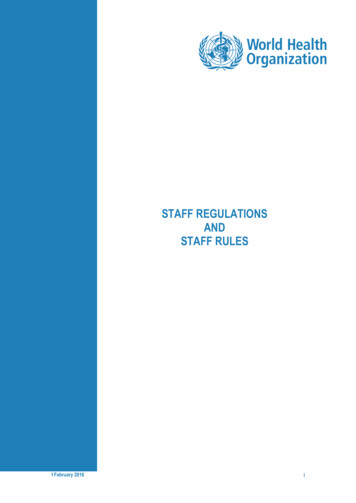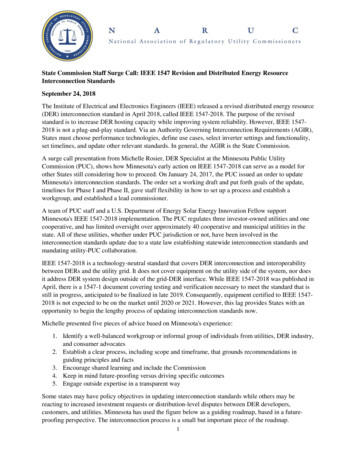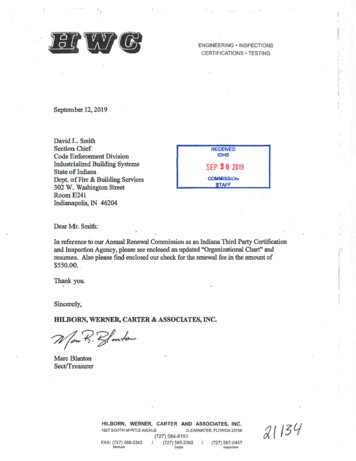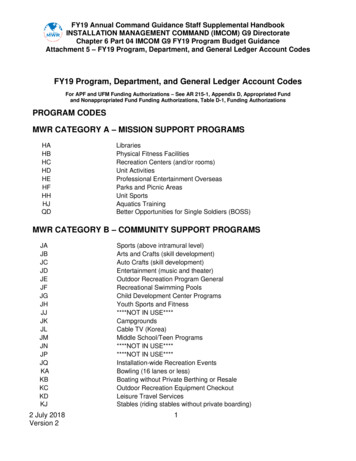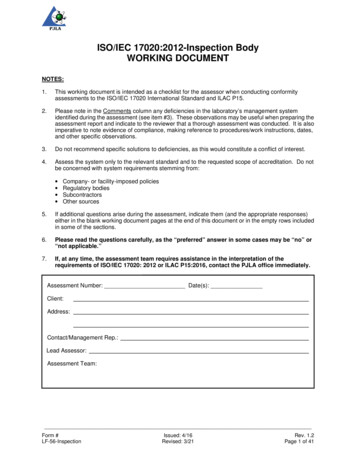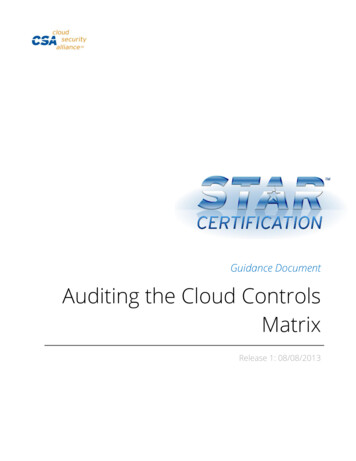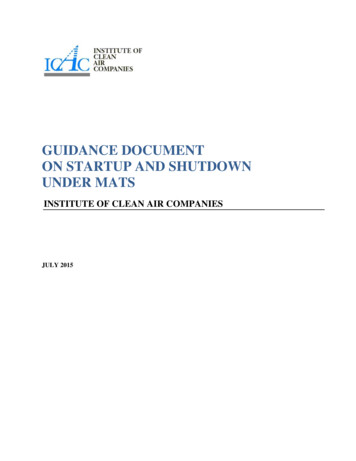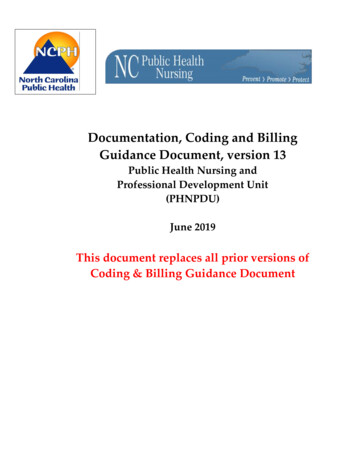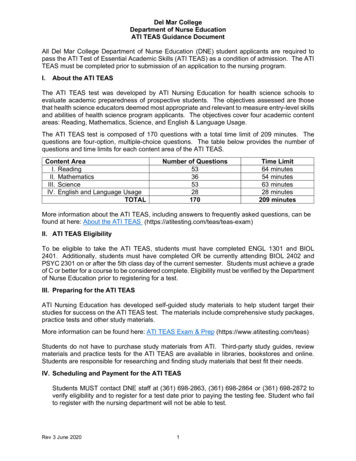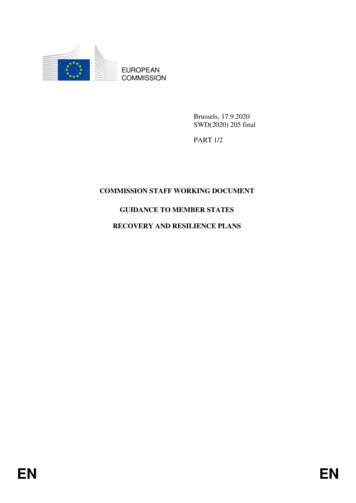
Transcription
EUROPEANCOMMISSIONBrussels, 17.9.2020SWD(2020) 205 finalPART 1/2COMMISSION STAFF WORKING DOCUMENTGUIDANCE TO MEMBER STATESRECOVERY AND RESILIENCE PLANSENEN
ContentsPART 1: GENERAL OBJECTIVES OF THE PLAN . 31.General objective/Executive summary . 32.Link with the European Semester . 73.Coherence . 8PART 2: DESCRIPTION OF REFORMS AND INVESTMENTS . 91.Description of the component . 92.Reforms . 113.Investments . 124.Green and digital dimensions of the component . 155.Milestones, targets, timeline . 216.Financing and Costs . 257.Loan request . 28PART 3: COMPLEMENTARITY AND IMPLEMENTATION OF THE PLAN . 291.Consistency with other initiatives . 292.Complementarity of funding . 303.Implementation . 334.Control and audit . 37PART 4: OVERALL IMPACT . 401.Strengthening the economic and social resilience . 402.Comparison with the investment baseline . 421
DISCLAIMERThis document is based on the Proposal for a Regulation on the Recovery and ResilienceFacility (hereafter ‘the Proposal’) adopted by the Commission on 28 May 2020 and takes intoaccount the conclusions of the European Council of 17-21 July 2020. It takes into account theco-legislators’ latest discussions on the proposal and will therefore be updated whennecessary, particularly once the co-legislators reach an agreement on the Regulation. Thedocument reflects in particular the scope and objectives of the Proposal (Articles 3 and 4), thestructure of the recovery and resilience plans (Article 15) and the corresponding assessmentcriteria in Article 16 and Annex II. The guidance is intended to help Member States prepareand present their recovery and resilience plans in a coherent way and is without prejudice tothe ongoing negotiations on the Proposal in the European Parliament and the Council.STRUCTURE OF THE DOCUMENTThe Proposal, in particular Article 15, outlines the information Member States need toprovide in their recovery and resilience plan. Article 16 and Annex II provide criteria for theassessment of the plans and criteria to specify the nature of the reforms and investments thatshould be part of the plans. The criteria will be taken into account by the Commission whenmaking its assessment under Article 16. The guidance and the proposed template (annexed)reflect this approach: Part I on the reform and investment objectives covers the overall contribution of theplan to the Proposal’s objectives and to the Semester priorities as well as the overallcoherence of the plan and its components.Part II covers a description of the individual reforms and investments, structuredthrough ‘components’.Part III covers the implementation of the plan and the complementarity with other EUprogrammes.Part IV covers the expected impact of the plan.TIMELINEAccording to the Proposal, Member States may submit their recovery and resilience plans atthe latest by 30 April 2021. They may also wish to send a draft plan as from 15 October2020. Member States are encouraged to have informal contacts with the Commission servicesas early as possible when preparing the plans. Member States are also invited to discuss withthe Commission the draft recovery and resilience plans together with their draft programmingdocuments for cohesion policy, including REACT-EU and the Just Transition Fund.2
PART 1: GENERAL OBJECTIVES AND COHERENCE OF THE PLANThe recovery and resilience plans need to reflect a substantive reform and investment effort.Both reforms and investments must be coherent and adequately address the challenges in theindividual Member State. The reform efforts and investment put forward must be substantialand credible. To this end and as indicated in Article 15(3), the recovery and resilience planshall be duly reasoned and substantiated. The Commission will assess the recovery andresilience plans prepared by the Member States on the basis of the criteria set out in Article16(3) and Annex II of the Proposal.The same procedure will apply to the assessment of both non-repayable financial contributionand loan requests, as explained later in this guidance. According to Article 11 of the Proposal,Member States may submit requests up to their maximum financial contribution to implementtheir recovery and resilience plans. According to Article 12, Member States can in addition tothis allocation request a loan support, with a maximum ceiling, if they can provide evidenceof higher financial needs linked to additional reforms and investments.1. General objective/Executive summaryBackground: Article 4(1): “The general objective of the Recovery and Resilience Facilityshall be to promote the Union’s economic, social and territorial cohesion by improving theresilience and adjustment capacity of the Member States, mitigating the social and economicimpact of the crisis, and supporting the green and digital transitions, thereby contributing torestoring the growth potential of the economies of the Union, fostering employment creationin the aftermath of the COVID-19 crisis, and promoting sustainable growth.”Member States are facing a number of challenges aggravated by and/or resulting from theCOVID-19 crisis that the Recovery and Resilience Facility will help to address. As anintroduction to their recovery and resilience plans and in the form of an executive summary,Member States are invited to describe: (i) the main challenges that they are facing and (ii)how addressing them through the recovery and resilience plan will contribute to theachievement of the following four general objectives:1.2.3.4.Promoting the Union’s economic, social and territorial cohesionStrengthening economic and social resilienceMitigating the social and economic impact of the crisisSupporting the green and digital transitionsThe executive summary should outline the main narrative of the plan. Member States areinvited to publish their plans to enable the European Parliament, the other Member States, theCommission and the public at large to have an overview of what the recovery and resilienceplan will achieve. It should be illustrated by key facts and figures that provide a quantitativeinsight into the overall estimated impact of the plan. Examples of such facts and figures areprovided below.Sub-section 1.1: General objectives of the plan and justification (facts and figures)1) Promoting the Union’s economic, social and territorial cohesion3
The Proposal is based on Article 175(3) of the Treaty on the Functioning of the EuropeanUnion (TFEU). As such, the Facility aims to promote the Union’s economic, social andterritorial cohesion by improving the resilience and adjustment capacity of the MemberStates, and by mitigating the socio-economic impact of the COVID-19 crisis and becoming(more) resilient. Member States should outline how their plan will contribute to enhancingcohesion, taking into account local, regional and national disparities. Overarching challengessuch as those linked to the demographic context can also be explained under this section.Examples of facts and figures: Member States are invited to provide for instance officialnational and regional statistics on income (level and distribution), population, education,skills or employment, including indications of trends and changes in these areas in recentyears and as a consequence of the COVID-19 crisis and their comparison with EU averages.Member States can also outline how the plan is expected to mitigate disparities and supportcohesion.2) Strengthening economic and social resilienceResilience refers to the ability to withstand and respond to shocks and challenges, andrecover quickly in a fair, sustainable and inclusive manner.1 The COVID-19 crisis has put totest the capacity of Member States and the Union to cope with large and unexpected shocks.The crisis is multidimensional. The pandemic has revealed the vulnerabilities of healthsystems to cope with high contagion rates and supply disruptions. The resulting economiccrisis is affecting Member States’ capacity to grow while exacerbating existing, and possiblycreating new, macroeconomic imbalances. There is also the need to strengthen the resilienceof some critical supply chains especially for sectors most exposed to external shocks.Member States should outline in this section how the plans will contribute to strengtheningtheir economic and social resilience, in particular how the implementation of the plans willsupport them to come out stronger from this crisis, be better prepared to address futurechallenges and reinforce the long-term competitiveness of the EU economy.Facts and figures: Member States are invited to provide data regarding the expected impactof the plan on macroeconomic stability, productivity and macroeconomic imbalances in therelevant cases, the strengthening of the social resilience (in relation to employment, skillsand social policies), in particular when it comes to the most vulnerable groups, the healthand care systems, the safeguarding of key value chains and critical infrastructure, ensuringaccess to critical raw materials, strategic autonomy, improved connectivity, thediversification and resilience of their key economic ecosystems, and the fitness of theirbusiness environment. Member States can also describe the impact of their plan on publicfinances and financial buffers in the private sector as an indicator of financial resilience.3) Mitigating the social and economic impact of the crisisMember States should outline in general terms how the plan responds coherently to theeconomic and social fallout of the crisis and in particular explain how the plan is expected toachieve a fast and robust recovery. The Member States are invited to explain in broad termshow the plans are coherent with, and effectively contribute to implementing the esilience-in-emu.pdf4
Pillar of Social Rights in relation to its dimensions of equal opportunities and access to thelabour market, fair working conditions and social protection and inclusion.Facts and figures: Member States are invited to provide indicators on the economic andsocial impact of the crisis, in particular from the social scoreboard. They can provideindicators to reflect the expected economic impact of the crisis on GDP, household income,health and care systems, unemployment, employment and activity rates, education, skills andlifelong learning, risk of poverty or social exclusion rates, as well as the impact onbusinesses. Member States are also invited to provide the expected impacts of the plan on theabove indicators. Member States are encouraged to highlight the social and economic impactacross various groups in the society (for instance distributional impact) and the situation ofvulnerable groups.4) Supporting the green and digital transitionsIn line with the political priorities of the Union, the Recovery and Resilience Facility isdesigned to foster a sustainable and inclusive recovery and promote the green and digitaltransitions. Member States should explain how the plans are coherent with the priorities ofthe European Green Deal and those set out in “Shaping Europe’s digital future”2, in particularhow the plan supports actions in full respect of the climate, environmental, social and digitalpriorities of the Union and the ‘do no significant harm principle’, and how each plan willconcretely achieve the 37% climate mainstreaming target. Furthermore, they shoulddemonstrate consistency with their National Energy and Climate Plan (or updates thereof).On digital, the Commission proposes that each recovery and resilience plan includes aminimum level of 20% of expenditure related to digital. Member States should explain howthe implementation their plan will contribute to the achievement of this target. For bothdimensions, Member States are also invited to explain how the proposed plan, in general, willensure that the workforce will be appropriate
3) Mitigating the social and economic impact of the crisis Member States should outline in general terms how the plan responds coherently to the economic and social fallout of the crisis and in particular explain how the plan is expected to achieve a fast and robust recovery. The Member States are invited to explain in broad terms how the plans are coherent with, and effectively contribute to .
